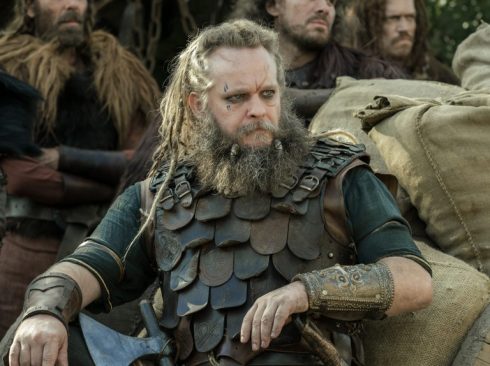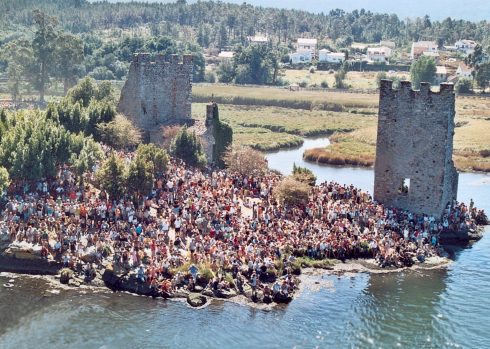SPAIN has more than its fair share of bizarre festivals, but the one that takes place on the first Sunday each August, in a town in Galicia, is most definitely one of a kind.
Few may know that you don’t have to travel to northern European climates to find a rich history of Viking invasions, for Iberia had its own running feud with Scandinavian forces, which is commemorated each year on the first Sunday of August.
This Sunday, Galicians will once again celebrate the defence of their coastline from the Vikings in an amazing reenactment of a centuries old battle using real norse longships.
So what’s the history behind the fiesta?
In 844, a fleet of Vikings longships with blood red sails journeyed down the french coast to the Iberian peninsula, having just pillaged the British Isles.
A contemporary account by 12th Century Andalucian historian Ibn Idhari described the invasion thus:
“Vikings arrived in about 80 ships. It was as if they had filled the ocean with dark red birds, in the same way as they had filled the hearts of men with fear and trembling. After landing at Lisbon, they sailed to Cadiz, then to Sidonia, then to Sevilla. They besieged this city, and took it by storm. After letting the inhabitants suffer the terror of imprisonment or death, they remained there seven days, during which they let the people empty the cup of bitterness.”
The raiding party led by the legendary Viking warrior Bjorn Ironside and Chief Hastein laid waste to many coastal Iberian towns, putting them to the sword and the flame. (Yes, the same Bjorn from the show Vikings!)

They rowed up the Guadalquivir river and besieged the city of Sevilla (then, Ishibilya). The Emir of Al-Andalus, Adbelrahman II, was enraged by the invasion of the norsemen and called all the able bodied men of his emirate to fight.
They assembled at Cordoba and marched on the Viking hoard. After a bloody battle on a hillside overlooking the town, the Andalusians were victorious: they reportedly slew ‘more than 1,000 Scandinavians’ and they burned 30 snakelike longships with Greek fire. (A primitive version of napalm invented by the ancient Greeks)
The Vikings were not disheartened by their defeat however, as they knew their fallen brothers had ascended to Valhalla, and were feasting in the hall of the Gods.

They continued their journey to the Balearic Islands: then finally they sacked and burned the town of Luca, Italy (thinking it was Rome).
And on their way home they raided Galicia a second time, even taking the king prisoner and allegedly ransoming him back for a fortune (though the evidence for this is shaky).
Abdelrahman II was rightfully terrified at the thought of another hoard of Vikings terrorising his emirate, so he ordered the construction of the walls of Sevilla in an attempt to defend against the berserkers.
Over the next two centuries, the Vikings would continue to pillage Iberia, proving a constant thorn in the side of both Christian and Muslim rulers.
Galicia was the primary target for the norsemen: the stunning and affluent cathedrals were the perfect target.
On numerous occasions, the Vikings sailed up the river Ulla and tried to sack Santiago de Compostela. Archeological digs, carried out in the 40s and 50s, revealed that defensive walls and towers were even built around the famous cathedral, to protect it from the Scandinavians.
What happens nowadays?
An annual festival is held in Galicia to commemorate the defence against the Vikings.
The Viking Festival of Catoira (Romería Vikinga de Catoira) has been held on the first Sunday of August every year since 1961, and will be held on August 1 this year too.
Before the festival proper, there is a week-long party held in Galician towns celebrating Galician culture. There is dance, food and even a music festival: Valhalla Music Fest, Catoira (July 30).
The festival culminates in a spectacular reenactment of longships landing on the shores. Thousands gather to witness the ‘attack’ by the ruins of the 11th century castle, the Torres del Oeste to watch and take part in this event.
But to understand this reenactment, we first have to go back 1000 years to the very same shores of Galicia with a grand fortress overlooking the mouth of the Ulla river.
Once again, blood red sails appear on the horizon as King Olaf II sails to Galicia, intent on pillaging Santiago.
He lands his longships ‘drakkar’ on the beach by the Torres del Oeste and is met by an ‘army’ of Galician peasants and farmers.
Miraculously, the Galicians fend off the Norwegian warriors and defend their lands, fighting tooth and nail for their homes and families.
So, every year during the Viking Festival of Catoira, this scene is reenacted at the exact same place where it occurred 1000 years ago.
Hundreds dress up in their best Viking warrior garments, face paint, fake blood and plastic weapons to take part in the event.
In fact, the festival makers, in collaboration with the Danish town of Frederikssund, made two replica drakkar to use during the ‘attack’. The ‘Frederikssund’ (a 20m by 2.9m Oseberg ship) and the ‘Torres del Oeste’ (a 17.5m by 2.5m Skudelev ship) are rowed and sailed during the landing by festival goers every year.

The scene would not be faithful without the brave Galicians on the coast, who are also present to valiantly defend their home from the marauding Vikings.
In total over 200 people take part in the reenactment and hundreds more in the parties before and afterwards. And the festival ends with everyone taking part in a verbena, a traditional Galician dance.
READ ALSO:
